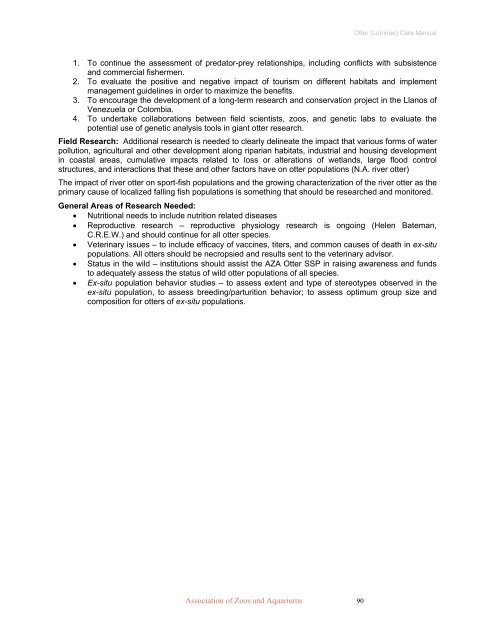Otter (Lutrinae) Care Manual - Association of Zoos and Aquariums
Otter (Lutrinae) Care Manual - Association of Zoos and Aquariums
Otter (Lutrinae) Care Manual - Association of Zoos and Aquariums
You also want an ePaper? Increase the reach of your titles
YUMPU automatically turns print PDFs into web optimized ePapers that Google loves.
<strong>Association</strong> <strong>of</strong> <strong>Zoos</strong> <strong>and</strong> <strong>Aquariums</strong> 90<br />
<strong>Otter</strong> (<strong>Lutrinae</strong>) <strong>Care</strong> <strong>Manual</strong><br />
1. To continue the assessment <strong>of</strong> predator-prey relationships, including conflicts with subsistence<br />
<strong>and</strong> commercial fishermen.<br />
2. To evaluate the positive <strong>and</strong> negative impact <strong>of</strong> tourism on different habitats <strong>and</strong> implement<br />
management guidelines in order to maximize the benefits.<br />
3. To encourage the development <strong>of</strong> a long-term research <strong>and</strong> conservation project in the Llanos <strong>of</strong><br />
Venezuela or Colombia.<br />
4. To undertake collaborations between field scientists, zoos, <strong>and</strong> genetic labs to evaluate the<br />
potential use <strong>of</strong> genetic analysis tools in giant otter research.<br />
Field Research: Additional research is needed to clearly delineate the impact that various forms <strong>of</strong> water<br />
pollution, agricultural <strong>and</strong> other development along riparian habitats, industrial <strong>and</strong> housing development<br />
in coastal areas, cumulative impacts related to loss or alterations <strong>of</strong> wetl<strong>and</strong>s, large flood control<br />
structures, <strong>and</strong> interactions that these <strong>and</strong> other factors have on otter populations (N.A. river otter)<br />
The impact <strong>of</strong> river otter on sport-fish populations <strong>and</strong> the growing characterization <strong>of</strong> the river otter as the<br />
primary cause <strong>of</strong> localized falling fish populations is something that should be researched <strong>and</strong> monitored.<br />
General Areas <strong>of</strong> Research Needed:<br />
• Nutritional needs to include nutrition related diseases<br />
• Reproductive research – reproductive physiology research is ongoing (Helen Bateman,<br />
C.R.E.W.) <strong>and</strong> should continue for all otter species.<br />
• Veterinary issues – to include efficacy <strong>of</strong> vaccines, titers, <strong>and</strong> common causes <strong>of</strong> death in ex-situ<br />
populations. All otters should be necropsied <strong>and</strong> results sent to the veterinary advisor.<br />
• Status in the wild – institutions should assist the AZA <strong>Otter</strong> SSP in raising awareness <strong>and</strong> funds<br />
to adequately assess the status <strong>of</strong> wild otter populations <strong>of</strong> all species.<br />
• Ex-situ population behavior studies – to assess extent <strong>and</strong> type <strong>of</strong> stereotypes observed in the<br />
ex-situ population, to assess breeding/parturition behavior; to assess optimum group size <strong>and</strong><br />
composition for otters <strong>of</strong> ex-situ populations.









